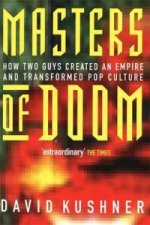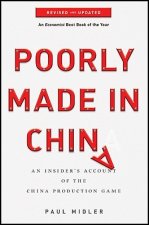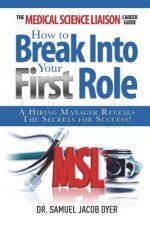
Kod: 04565065
ABB
Autor Kevin Barham, Claudia Heimer
"If we didn't write this book, we would be dying to see it published. Whenever one reads about ABB in the management literature, there is a 'no questions asked' quality of 'if ABB has done it, why can't you, it must be the right t ... więcej
- Język:
 Angielski
Angielski - Oprawa: Miękka
- Liczba stron: 400
Wydawca: PEARSON Education Limited, 1998
- Więcej informacji o książce

Zobacz książki o podobnej tematyce
-

Ultimate Book of Cities
88.69 zł -23 % -

Critical Role: The Mighty Nein Origins - Yasha Nydoorin
74.80 zł -5 % -

Ultimate Book of Airplanes and Airports
88.69 zł -23 % -

High-Performance Java Persistence
206.90 zł -

Star Wars: Darth Vader - Dark Lord Of The Sith Vol. 4: Fortress Vader
85.57 zł -5 % -

Ultimate Book of Space
88.69 zł -23 % -

Grinding it out
51.44 zł -11 % -

Toyota Production System
258.75 zł -

Grey
47.01 zł -14 % -

Chit Chat 1: Activity Book
51.94 zł -2 % -

How to Babysit a Grandma
38.25 zł -23 % -

How To Draw Lifelike Portraits From Photographs
115.07 zł -11 % -

Marina Abramovic
280 zł -

Henry Ford
113.56 zł -5 % -

How to Babysit a Grandpa
41.47 zł -5 % -

PHP Beyond the Web
209.82 zł -

Creative Colored Pencil
100.17 zł -11 % -

Bach: The Orgelbuchlein
191.80 zł -

Chit Chat: 1: Teacher's Book
187.57 zł -

RNA/DNA and Cancer
977.55 zł -

Cambridge History of the Cold War
173.47 zł -4 %
Powiadomienie o dostępności
Wpisz swój adres e-mail, aby otrzymać od nas powiadomienie,
gdy książka będzie dostępna. Proste, prawda?
Więcej informacji o ABB
 Opis
Opis
"If we didn't write this book, we would be dying to see it published. Whenever one reads about ABB in the management literature, there is a 'no questions asked' quality of 'if ABB has done it, why can't you, it must be the right thing to do. This is the way to do it, this is what ABB have done.'"- Claudia Heimer & Kevin Barham There is almost an ABB doctrine that fascinates both scholars and managers. Why is ABB so interesting to managers and gurus alike? Why is it the world's favorite case study? Why is Percy Barnevik possibly 'the most influential manager in the world' (according to the Observer newspaper) In June 1987, Beat Hess, head of the legal department of the world-famous Swiss electro-technical firm BBC Brown Boveri, was about to take his family on a well-earned week's holiday to Italy. He was suddenly told by BBC's chairman Fritz Leutwiler and chief executive Thomas Gasser, to prepare a full draft agreement for the 'unthinkable' - negotiations for a merger with long-time rival ASEA, the Swedish power engineering firm that had been gaining ground on Brown Boveri ever since a new CEO, Percy Barnevik, had taken over in 1980. If it came off, this would be the largest cross-border merger in history. Hess was told to go ahead with his holiday if he wanted to, but that the agreement had to be completed by the first week in July. The handwritten draft with its coffee and suntan lotion stains that Hess brought back from Italy was to be the basis for what has now become a legend of corporate history. ABB has grown to be the leading power engineering company in the world. It doubled its size in six years and is now a $31 billion corporation employing 213,000 people in 50 or more countries, including all the major markets, around the globe. According to the last three years' surveys in the FT, it is Europe's most admired company and Percy Barnevik, Europe's most admired CEO. How do we make sense of what ABB has achieved? Their success, in one of the most fiercely competitive industries in the world, a success which is all the more remarkable for a company which pioneered a new form of global organization. Percy Barnevik has described the paradoxes that ABB has tried to resolve as the simultaneous attempt to be 'global and local, big and small, and radically decentralized with central reporting and control.' In essence, Barnevik and his senior colleagues at ABB have tried to resolve these contradictions by creating what we call a 'globally-connected corporation', a loose-tight network of processes and partners which can only be held together by highly committed people and strongly-held principles. The gurus fell in love with ABB very quickly...Tom Peters calls ABB a 'buckyball organization' and says that Percy Barnevik is the most insistent enemy of bureaucracy that he has ever met. Manfred Kets de Vries has described the challenge of managing ABB as 'making a giant dance', While it may not be a model for every other company, it is certainly an example of what most companies can achieve. ABB The Dancing Giant gives its reader the exciting opportunity to look through the keyhole and hear from some very interesting people around ABB, both in the corporate headquarters and locations world-wide. It will also satisfy their curiosity about the heritage of Percy Barnevik, who has almost come to personify the company. It will look at how the company is doing now that he has passed on the role of CEO to Goran Lindahl. You will be able to look behind his image and public statements and find out what other people in the company think, how they lived the story of the merger, and what life is like for them in the organization. ABB the Dancing Giant has not been written simply for the sake of a fascinating history, which it certainly is, but to ask ourselves what other managers who are faced with the challenges of globalisation can learn from the story. It will : * document the story of the merger and of ABB's growth and global expansion * catch a greater glimpse of the real story behind the company's on-going success * raise some key questions for the future of ABB - how is Goran Lindahl preparing ABB for the next Millennium? * highlight some lessons from ABB's experience for managers in other organizations facing international and global challenges * be a frank look at the good and bad of ABB and what other managers and companies can learn and implement from this story. Authors: Kevin Barham is Director of the Ashridge Center for Management and Organization Learning and a founding partner of the Global Development Partnership. His research has focused on the development of international managers - a topic where ABB itself has much to teach other organizations. Claudia Heimer is Business Director and a member of the management team of Ashridge Consulting, where she has been interested in the cultural, strategic and IT implications of globalisation Outline Contents Part One : The Birth of a Modern Giant The story of the two companies that came to form ABB, ASEA of Sweden, and BBC (Brown Boveri Corporation) of Switzerland. Includes insights into the details of the merger talks, the high emotions involved and the way that Percy Barnevik drove the negotiations to a successful outcome. Part Two : Giant Steps to the Globally-Connected Corporation Looks at ABB's global expansion and looks at ABB through a number of different lenses. Looks at ABB as the 'globally-connected corporation' and sets ABB in the context of the global transitions that more and more firms are having to make to compete in a globalised world. Includes an overview of four of the most important analyses of ABB by leading management gurus. Part Three : Reaping the Harvest The organization a decade after the merger - find out how the masterplan has worked out so far. Looks more closely at why ABB has become the world's favorite case study and at why it is an example of that rare organizational breed, a successful cross-border merger. Postscript : The Future of ABB ABB has successfully completed its first decade of existence and occupies the corporate Mount Olympus together with General Electric and Microsoft, but what does the future hold? How can ABB sustain and build on their success? How will Goran Lindahl shape up now Percy Barnevik has given him control?
 Szczegóły książki
Szczegóły książki
Kategoria Książki po angielsku Economics, finance, business & management Industry & industrial studies Manufacturing industries
- Pełny tytuł: ABB
- Podtytuł: This giant has learned to dance
- Autor: Kevin Barham, Claudia Heimer
- Język:
 Angielski
Angielski - Oprawa: Miękka
- Liczba stron: 400
- EAN: 9780273628613
- ISBN: 0273628615
- ID: 04565065
- Wydawca: PEARSON Education Limited
- Waga: 600 g
- Wymiary: 230 × 155 × 24 mm
- Data wydania: 15. December 1998
Ulubione w innej kategorii
-

Masters Of Doom
56.48 zł -23 % -

Textiles and Clothing, c.1150-1450
150.11 zł -9 % -

Food Politics
125.55 zł -4 % -

Food and Beverage Management in the Luxury Hotel Industry
140.15 zł -5 % -

Golden Thread
61.11 zł -23 % -

Glitter Plan
77.72 zł -11 % -

Pour Your Heart Into It
55.97 zł -37 % -

Salt, Sugar, Fat
79.43 zł -23 % -

American Icon
75.50 zł -14 % -

Genentech - The Beginnings of Biotech
72.58 zł -

Eating Animals
43.39 zł -15 % -

Basic Butchering of Livestock and Game
81.35 zł -11 % -

For God, Country, and Coca-Cola
97.45 zł -5 % -

World Class Manufacturing Casebook
85.98 zł -

Arms of Krupp
107.62 zł -11 % -

Auto Brand
177.10 zł -

Professor Porsche's Wars
88.69 zł -23 % -

Empire of Pain
50.43 zł -26 % -

Poorly Made in China
73.39 zł -4 % -

Made in the USA
96.45 zł -10 % -

Bean to Bar Chocolate
88.69 zł -11 % -

Waste
61.11 zł -23 % -

Lexus - the Relentless Pursuit Revised Edition
101.78 zł -4 % -

Faster, Higher, Farther
57.28 zł -10 % -

Concorde Pocket Manual
51.84 zł -23 % -

Unsavory Truth
126.45 zł -10 % -

Hard Sell: Now a Major Motion Picture LOVE & OTHER DRUGS
63.52 zł -

Food Futures
118.40 zł -15 % -

Free as in Freedom
94.03 zł -5 % -

Analysis Techniques for Racecar Data Acquisition
538.96 zł -

Field Visual Merchandising Strategy
124.94 zł -9 % -

Don Hayter's MGB Story
139.34 zł -

Mi-28. Night Hunter and Others
139.34 zł -

Restaurant Babylon
74.80 zł -23 % -

Ethics of What We Eat
83.56 zł -

Data Acquisition from HD Vehicles Using J1939 CAN Bus
442.20 zł -

Inside Apple
108.63 zł -

Insane Mode
52.35 zł -15 % -

Lean for the Process Industries
300.44 zł -

Feasibility Study
190.13 zł -4 % -

Jet Sex
159.17 zł -5 % -

Topology Optimization in Engineering Structure Design
828.44 zł -

Plant Nutrient Disorders
979.27 zł -

Medical Science Liaison Career Guide
291.88 zł -

Privatizing Poland
182.53 zł -

Yak-1, Vol. II
172.77 zł -

Cadbury Story
61.41 zł -

Quench Your Own Thirst
81.35 zł -11 % -

Bacardi And The Long Fight For Cuba
85.57 zł -5 %
zadowolonych klientów
Od roku 2008 obsłużyliśmy wielu miłośników książek, ale dla nas każdy był tym wyjątkowym.
Copyright! ©2008-24 libristo.pl Wszelkie prawa zastrzeżonePrywatnieCookies



 21 milionów książek
21 milionów książek Dostawa 10.99 zł
Dostawa 10.99 zł (32) 444 93 66 (8-15.30h)
(32) 444 93 66 (8-15.30h)